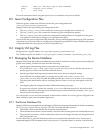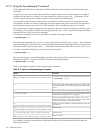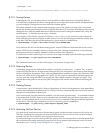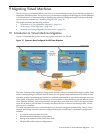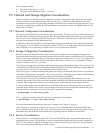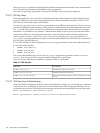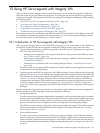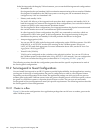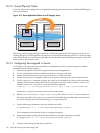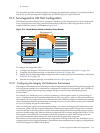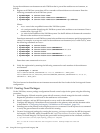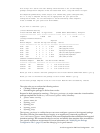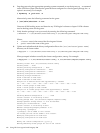
10 Using HP Serviceguard with Integrity VM
After you have installed Integrity VM and created the guest, you can install Serviceguard on either the
VM Host system (to provide failover for the guest), or on the guest (to provide failover for applications
running on the guest). This chapterdescribes how to configure Serviceguard with IntegrityVM, including
the following topics:
• “Introduction to HP Serviceguard with Integrity VM” (page 115)
• “Serviceguard in Guest Configurations” (page 116)
• “Serviceguard in VM Host Configuration” (page 119)
• “Upgrading from Integrity VM A.01.20 Toolkit” (page 126)
• “Troubleshooting Serviceguard with Integrity VM” (page 127)
This chapter assumes you are familiar with HP Serviceguard. The procedures in this chapter use the HP
Serviceguard commands to accomplish Serviceguard tasks. You can use Serviceguard Manager instead.
For more information, see the Managing Serviceguard manual.
10.1 Introduction to HP Serviceguard with Integrity VM
After you set up Integrity VM, you can install HP Serviceguard A.11.16 or later either on the VM Host or
on the HP-UX guest. Do not use Serviceguard on both the VM Host and the guest at the same time.
• To protect guest applications, install Serviceguard on the HP-UX guest. Applications on a guest can
fail over to any of the following:
— Another guest configured as a Serviceguard node that is running on the same VM Host system
(see “Cluster in a Box” (page 116))
— Another guest configured as a Serviceguard node running on a different VM Host system (see
“Virtual/Virtual Cluster”)
— Another server or nPartition that is not running Integrity VM (see “Virtual/Physical Cluster”
(page 118))
Windows guests do not support HP Serviceguard; therefore, Windows guest applications cannot be
configured as Serviceguard packages.
• Toprotect guests, install HPServiceguard on the VM Hostsystem. Guests configured as Serviceguard
packages (distributedguests) are subsequently managed usingHP Serviceguard commands.If the VM
Host system fails, the distributed guest automatically fails over to another node in the Integrity VM
multiserver environment. Integrity VM guests which can relocated between Integrity VM Hosts are
configured into an Integrity VM multiserver environment that contains the same set of servers as is
in the Serviceguard cluster. (For more information, see “Serviceguard in VM Host Configuration”
(page 119)). Guestsof any operatingsystem (HP-UX and Windows) canbe configured as Serviceguard
packages.
Each Serviceguard configuration provides a level of protection against failure. Choose the configuration
that best meets your needs, keeping the following requirements in mind:
• Storage Requirements
To make sure the Serviceguard configuration is managable, use identical backing stores on both the
primary node and alternate nodes. To use Serviceguard in Guest configurations, the backing storage
units must be whole disks. Integrity VM does not support using other types of backing stores on
primary and alternate nodes for applications that are configured as Serviceguard packages.
The VM Host system storage configurations must comply with both Integrity VM and Serviceguard
product requirements. For information about the Integrity VM storage subsystem, see “Creating
Virtual Storage Devices” (page 61).
• Network Requirements
To make sure network communication with guests is always available, provide identical network
devices on both the primary and alternate nodes. Physical NICs (pNICs) and vswitches must be the
same on both the original and adoptive nodes for virtual NICs (vNICs) to function after the failover.
For moreinformation about the IntegrityVM networking subsystem,see “Creating Virtual Networks”
(page 89).
10.1 Introduction to HP Serviceguard with Integrity VM 115



